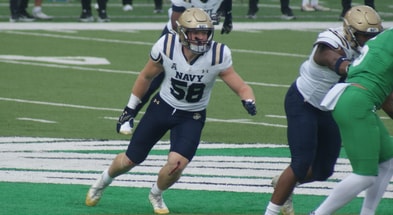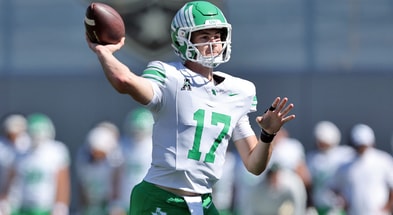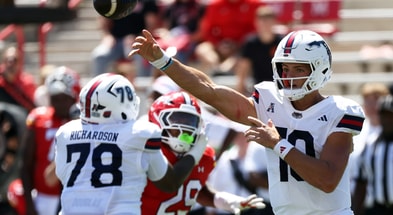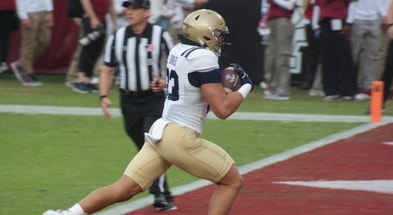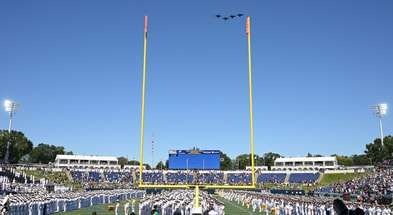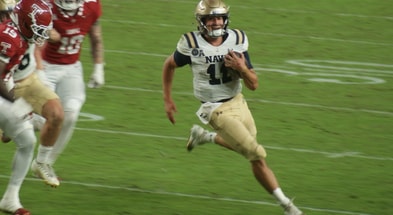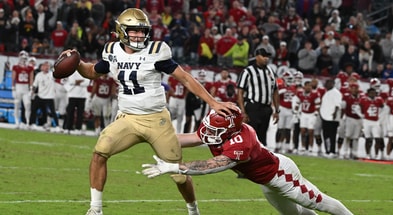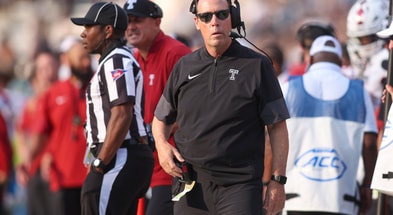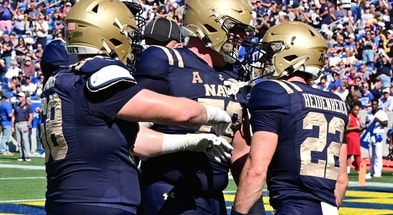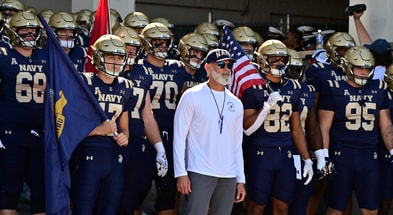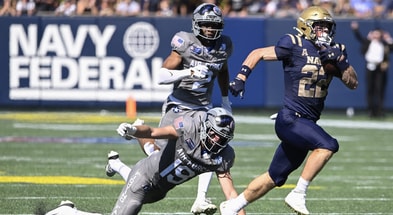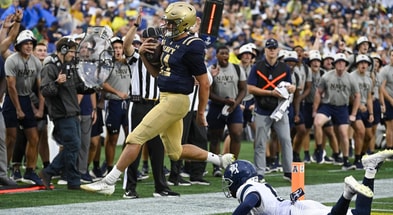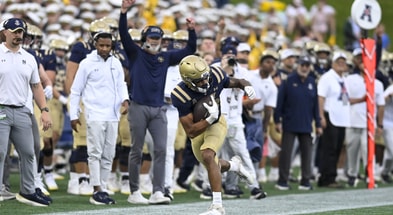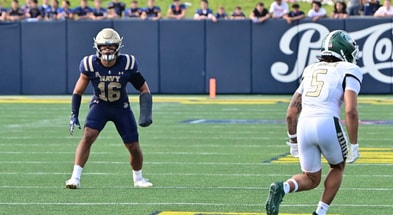The FAU Debrief
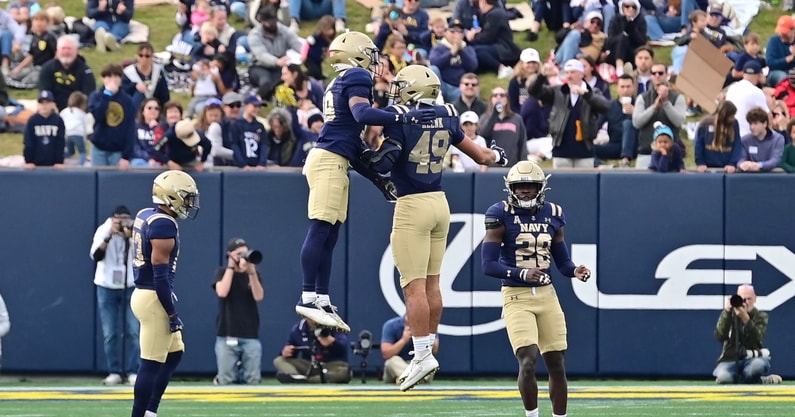
When Navy fans look back on the 2024 season, they’ll remember a ten-win campaign capped off by wins over Army and Oklahoma. But football seasons are long, and the success at the end can make people forget the struggles the team endured earlier.
One such problem for the Mids was run defense. The Mids gave up 274 yards on the ground to Memphis, starting a five-game stretch where opponents averaged 215 rushing yards per game and nearly five yards per carry. For a team that was usually so stout against the run, it was jarring. Something seemed off.
Then the Mids headed to Tampa to face a USF team that had just run for 319 yards a week earlier. But in this game, Navy was dominant, holding the Bulls to 25 carries for 60 yards in a 28-7 win. Over their last five games, the Mids limited their opponents to a far more Navy-like 3.67 yards per carry. A switch had flipped, and what was once a problem suddenly became a strength.
I’m not quite ready to say the same thing happened to Navy’s pass defense on Saturday in their 42-32 win over Florida Atlantic; it’s hard to argue that 381 passing yards is indicative of a lockdown defense. However, the Mids undoubtedly took a step forward.
After back-to-back games where the secondary made game-threatening mistakes, Navy shook up the lineup. Phillip Hamilton moved from cornerback to safety. Ira Oniha replaced him at cornerback. Justin Ross returned to the lineup at the other corner, and Bryce Allen played extensively as a nickel back. At linebacker, Coleman Cauley got his first start, and Adam Klenk got extensive playing time. Head coach Brian Newberry said that he’d be taking a hard look at personnel during the bye week, and sure enough, changes were made. And they worked.
This game had been billed as a supreme test for Navy’s defense. The Mids looked disjointed against Temple, making fundamental coverage mistakes and struggling to call plays on time. Facing FAU, with the fastest-paced offense in the country and the #4 passing offense, seemed like the wrong team at the wrong time. Instead, Navy’s defense completely controlled the tempo of the game.
Navy’s game plan confused FAU quarterback Caden Veltkamp to the point that the Owls abandoned their up-tempo pace for most of the game. Perhaps the best evidence of this was that they were penalized for delay of game and had to call a timeout to avoid a second one. After the snap, Veltkamp was unable to find a rhythm, holding onto the ball longer and going through progressions he doesn’t usually have to. Navy’s game plan showed a fundamental understanding of how Air Raid offenses work and how to make the quarterback uncomfortable.
The best defenses Navy faces, other than games like Notre Dame where the other team is just filled with monsters, are the ones that know the quarterback’s keys and try to give him something different on every play. The Air Raid works in much the same way; the quarterback identifies the coverage before the snap, picks out the defender he’s keying on, and delivers the ball based on what that key does. The book on defending the Air Raid is to disguise your coverage so that the quarterback either can’t identify his key, or keys on the wrong guy.
Navy’s defense did an excellent job looking like one coverage before the snap, then doing something different after the snap. Here, they look like man defense before the snap, then drop into a Tampa 2:
They were so good at simulating man coverage before the snap that they actually had a defender follow the motion man, then drop into a zone afterward:
I doubt this is the first time anyone’s tried this, but I don’t recall seeing it before.
The defense often rushed four, but they did a good job disguising who the fourth rusher would be.
Navy does this all the time, so it wasn’t something special cooked up for FAU. But both the offensive line and the quarterback seemed to struggle with it.
The most common look the Mids gave the FAU offense was a cover-2 pre-snap and a quarters look after the snap. Sometimes Navy rushed three, sometimes four, and sometimes three with a spy on the quarterback.
The key to these plays was that the pass rush remained effective even when rushing only three or four. Even if Veltkamp was confused about his keys, if he had enough time to sit in the pocket, he would eventually find an open receiver. But finding one under pressure with 7-8 in coverage is a lot easier said than done.
The defense also used quarters coverage while having seven on the line of scrimmage at the snap. The quarterback couldn’t pick out his key before the snap because he didn’t know who was dropping into coverage, or if any of them were.
Now, it’s not as if FAU didn’t move the ball; Veltkamp threw for 299 yards. But the majority of his passing was on checkdowns. Navy forced FAU to drive the length of the field, where they stalled in the red zone.
The exception was on FAU’s first possession, where they got their one long touchdown pass of the game. This looked like a communication mix-up on the defense’s part. FAU motioned their outside receiver into the slot, and the cornerback and safety traded responsibilities. The safety looked like he thought it was man, and pointed to the corner to tell him which receiver to cover. The corner, however, lined up with outside leverage on the receiver, as if he expected the inside help he’d get if it was quarters coverage. When the safety broke on the underneath route, the cornerback was left in a bad spot.
Fortunately, that seemed to be the only real mix-up of the day. After an error-filled performance in their last game, this was a welcome reboot for the defense.
Offensively, Navy had it easy in the first half. When we looked at the FAU-Rice film, we noted how aggressive FAU’s safeties were and wondered whether they would be the same against a more downfield-oriented passing game. They were not.
Navy did a lot of the things they always do, but the one element that drove the offense more than anything was FAU’s respect for Eli Heidenreich. Wherever Heidenreich lined up, the safety on that side either stayed deep or covered him rather than attacking the ball carrier. Without a safety in actual run support, Navy had a numbers advantage any time they ran to Heidenreich’s side.
(Apologies for the first play… Heidenreich is in the backfield, but I accidentally highlighted Jake Norris. Still on the correct side of the formation, though, so the concept still applies.
FAU tried to find ways to be aggressive without risking a Heidenreich downfield pass. They tried moving the opposite safety up to linebacker depth, but that didn’t work.
They tried moving the safety up and dropping the cornerback into coverage, but that still keeps the numbers the same.
Eventually, FAU decided to bite the bullet and get aggressive with the safeties. This is when they started having some success.
It took a while for Navy to find the proper adjustment in response, but eventually, they just ran the triple option from under center, blocking FAU like they would with any other safety in run support.
And that was that.
The FAU game was far from perfect, but it was a meaningful step forward for a defense that was still searching for answers. The Mids made several changes, and they all seemed to work out. Cauley was named the conference’s defensive player of the week after recording nine tackles, two forced fumbles, a fumble recovery, and an interception.
Look where he starts the play on his forced fumble and recovery:
I also thought Hamilton played very well in his first start at safety. We knew he’d be fine in coverage, but the plays he made closer to the line of scrimmage are what stood out to me. If he’s comfortable there, opening the door for Ross and Oniha to be on the field at the same time is a bonus.
Navy still has work to do defensively, but after this game, I feel better about where they stand. Now they have something to build on as they head into the meat of their schedule.
